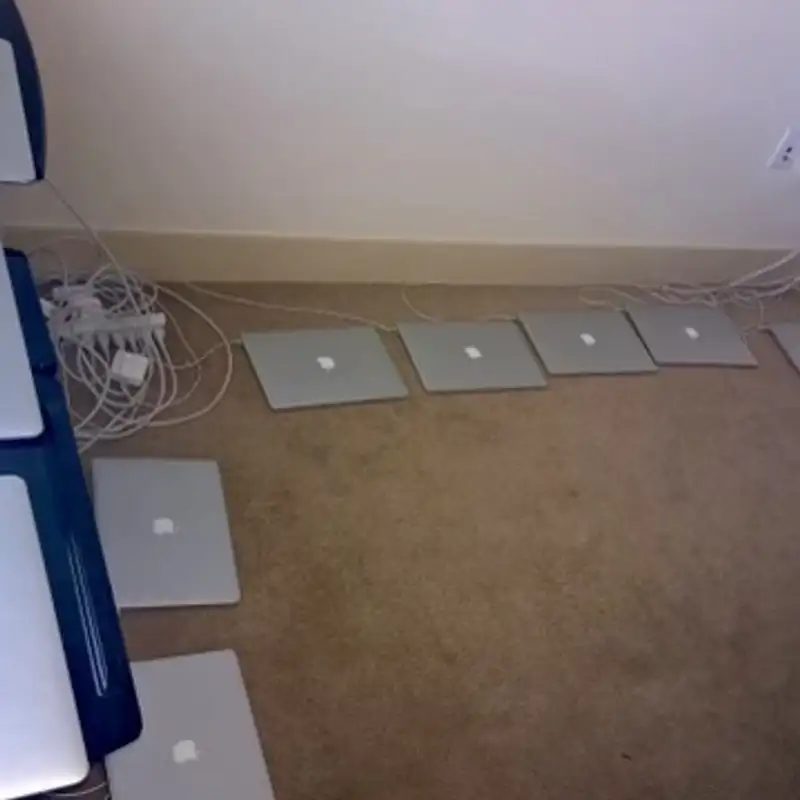32 MacBook Airs on the Floor
32 MacBook Airs on the Floor
Learn to Code
In 2009, I had an inbound sales job with a boss who thought she was a genius. Her plan? Calls in the morning, follow-ups in the afternoon. Problem was, I closed most of my sales on the first call. By noon, I was staring at four empty hours a day.
“Learn to code” was buzzing everywhere, so one afternoon, I Googled it. The internet pointed me to Python, and a book called Learn Python the Hard Way. It sounded honest—no bullshit promises—so I went for it. I learned the Terminal, wrote loops, memorized SQL queries, and kept going until Object-Oriented Programming went over my head.
But then the sales job hit a dead end. They wouldn’t let me make more money, wouldn’t promote me to manager, not even supervisor. Why waste my time? I quit. I wasn’t aiming to be a programmer yet, but coding suddenly felt less like a hobby and more like an escape hatch.
Funny how some random Googling during dead office hours can rewrite your whole story.
The Idea
The most money I’d ever made was selling shoes online back when I lived in a tiny bedroom caddy-corner to Madison Square Garden. I’d hustle inventory out of that shoebox apartment, shipping around 30 packages a day before running out of space—or time. It was good money, but my growth was boxed in, literally.
The idea started forming: What if I could sell without the limits of physical inventory? By then, drop shipping and affiliate networks existed, but they weren’t going to make anyone rich. I wanted to go bigger. I read a book on high-frequency trading, and it crystalized something for me: e-commerce could be high-volume, low-margin arbitrage. Sell fast, cheap, and at scale.
What if I didn’t own the products? What if someone else shipped them? I could sell pictures, collect money upfront, pay later, and never touch the product. It sounds normal now, but back then, it was borderline revolutionary—and I couldn’t stop thinking about it.
Execution
But what to sell? I threw everything at the wall: cell phone accessories, dolls, home goods. Nothing worked—until it did. Books. Suddenly, $25 a day turned into $100. Manually listing and managing everything became impossible, so I turned to oDesk (now Upwork) and hired virtual assistants. For $0.30 to $3.00 an hour, I got skilled freelancers from the Philippines and India who kept the operation running.
That was my real crash course in programming. Teaching low-skilled workers who barely spoke English required obsessive attention to detail, clarity, and simplicity. Every process had to be broken down to its bare bones. It was like debugging human workflows—and it paid off.
With their help, $100 a day became $200, and I could afford to hire actual programmers. I tried everywhere: Ukraine, India, Romania, Argentina, the UK, even the US. Nobody could pull it off. This wasn’t basic software or web development. Scraping Amazon required creativity, borderline street smarts. Miss a real-time price? I lost money. Sell an out-of-stock item? I lost big money.
Eventually, I cracked the code. When the system worked, it was eerily efficient. I’d know when a celebrity died before the news broke because their merchandise sales would spike. I’d keep raising prices and watch profits roll in. Rest In Profits.
Scaling
Making more than a high-paid sales job is nice. Doing millions in sales? That takes scaling. And for me, scaling took relentless Googling. I spent days, weeks, months searching for a developer who could actually help me grow. Then I stumbled on an obscure article in the Princeton student newspaper about a Computer Science student buying used textbooks on eBay and flipping them on Amazon. He could code and understood the game. Jackpot.
I tracked down his email and pitched him. He agreed to build my arbitrage software for $600 a month. Eventually, he wanted in on the action and bumped his rate to $1,200, claiming he could turn it into a real business. Fine. I locked him into a contract so he couldn’t offer his services to other booksellers. I had that market on lock.
Then Christmas came. He saw my holiday sales numbers and lost his mind. Suddenly, he wanted $6,000 a month. Anyone who knows retail understands Christmas is wild—it’s not a year-round thing. Paying peak season prices 12 months a year? Absolutely not. That’s when my trusted partner turned into my biggest rival.
Necessity is the Mother of Invention
Every entrepreneur hits a point where they have to choose: fold, or figure it out. I needed software. No one could build it, and the one person who could wanted to bleed me dry. Tim Cook’s mantra, “Own the crucial parts of your business,” echoed in my head. Fine. I’d write the damn software myself.
I knew a little Python and discovered a tool called Sikuli. It was brilliant—automation based on what you see on your screen. Take a screenshot of a button, tell it to click, and boom: it works. It was like hiring a $3/hour virtual assistant that never slept. True automation.
The only problem? When Sikuli ran, my computer was locked up. I needed another machine. A cheap Linux PC was a disaster. Windows? Better, but inconsistent. My trusty MacBook Air worked best, so I bought another one. Then another. And another.
Office Space
My software wasn’t perfect, but my internet was worse. High latency and inconsistent speeds crashed my program constantly—error handling wasn’t in my skillset back then. Throwing money at the problem worked for MacBook Airs, so why not for internet?
Google Fiber was rolling out in a few cities, and Kansas City was the closest option. I even considered moving there. But then I saw an ad in Boulder’s newspaper (the one for weirdos) about an office park installing Colorado’s first gigabit internet.
I called immediately, toured the place the same day, and signed a lease on the spot. Three years, $900 a month—for a small three-room office in a fancy building. By then, that was pocket change. As soon as the fiber was installed, I moved my growing fleet of MacBook Airs in. It was game on.
Luxury High-rises
At first, I lived in the Denver Tech Center while my office was in Golden, CO. Commuting? Hard pass. So I snagged an apartment in Golden, right next to the office. My backyard was Table Top Mountain, with a trailhead steps from my door. Deer would wander by while I hiked, taking in the perfect view of the city.
A year later, a new luxury high-rise opened in Downtown Denver—with gigabit internet. I upgraded. Instead of looking at the city, I was looking at the mountains. Life was partying hard and hustling harder. But when the lease was up, they raised the rent. Then raised it again. Denver’s cool, but it’s not California cool.
So, I Googled. Turns out, for the same price, I could get a super-luxury condo on the Strip in Vegas, complete with valet parking and a killer view of the action. Some people barely survive a Vegas weekend. I thrived there for a year.
Fork in the Road
Arbitrage opportunities don’t last forever. Profits dropped, and my competitors—led by my old partner—got dirty. Negative reviews, copyright claims to take down my listings. I fought back with lawyers and held my ground, but after six years, I knew the game was up. It was time for something new.
Normally, I’d dive into another business, but I faced two problems. First, running a business while coding it is brutal—it’s better to do one or the other. Second, while my arbitrage business broke the physical limits of selling shoes, I’d hit a new ceiling. Sure, I was doing millions in sales, but I was just a big fish in a small pond. I needed a bigger pond.
So, I made the leap: I decided to become a real software developer. That meant starting over, taking a huge pay cut, and learning to thrive in an entirely new world. I sold all 32 MacBook Airs and bought a single MacBook Pro. One machine, one new direction.

